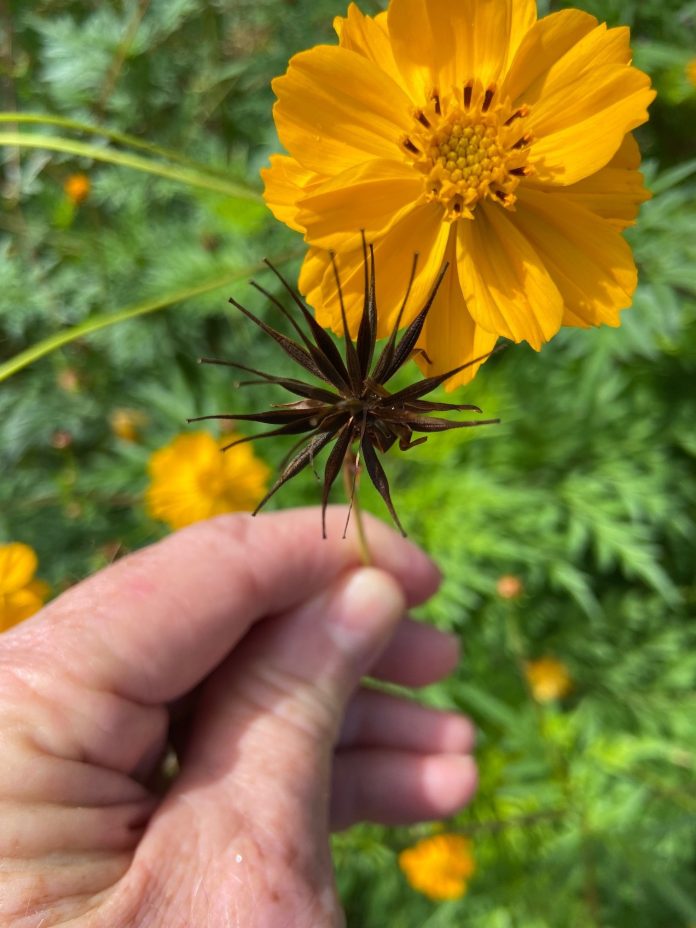Sometimes, life is just going to seed.
We think that can be a good thing. The life of a plant, in three words, is growth-flower-seed. This time of year, we are in a seedy place.
Where your vegetable and flower garden are concerned, you have an opportunity to harvest seeds to grow for next years’ garden. Here is what we recommend for best results:
Harvest seeds when they are brown and dry. If you cannot avoid harvesting when seed pods or seeds are wet, be sure to dry them thoroughly by placing them in a sunny window indoors for several days. Package them up in paper envelopes, labelled at the time of harvest (or you might forget what they are) and store in sealed containers like a mason jar. Drop a silica gel packet into the jar for a week or so to absorb any remaining moisture. Most pill bottles, or dry products in containers, contain silica gel. Save a few for this use.
Most seeds fall off the finished bloom to the ground or eaten by foraging songbirds. Some are best removed from their seed pod or husk by hand before they fall or get eaten. Marigolds, zinnias, sunflowers, hollyhocks, and calendula seeds are best harvested this way. Others, like poppies, can be harvested with a sharp shake of the pod, held upside down over a bowl.
Harvesting seeds:
The “low hanging fruit” are easy to harvest, store and germinate. These include beans, peas, nasturtiums, and corn, featuring large seed. Here are some other popular garden plants that produce seeds worth the harvest:
Lettuce plants bolt to seed this time of year. Wait for the puffy flower heads to dry on the plant and place the whole flower in a paper bag and shake to remove the hard, black seeds.
Basil produces tiny black seeds this time of year if you allow it to flower. Remove the spent flowers when dry and place in a colander or fine sieve. Gently rub them against the bottom of the sieve or colander until the tiny seeds are dislodged, into a bowl, preferably a white bowl that contrasts the colour of the seeds. Salvia seeds can be harvested in this way also.
Carrots and beets are biennial, meaning, they finish their growth cycle in the second year. Here in Canada, it is best to leave the plants to produce a flower this fall and stand over the winter. Some will produce flowers come spring. Allow the flowers to mature and go to seed, remove them and store for later sowing.
Tomato seeds are a bit tricky to retrieve and store, but worth the effort.
- Make sure you are harvesting seeds from an heirloom or heritage variety.
- Cut the tomato in half and squeeze the juice, gel, and seeds into a clean bowl.
- Pour three times as much water over the mess that you have created in the bowl. Mix it all up with your fingers. We find that it helps to pretend we are children while performing this task.
- Let stand for a few minutes and note that some seeds will have sunk in the liquid and others are floating. The sinkers are the winners that will produce plants come spring.
- Drain off the liquid and retrieve the sunken seeds, laying them out on paper toweling in a sunny window. Let dry for a week, then pick them off the towel, into paper envelopes, and place the envelopes in sealed containers.
The seeds that produce a new plant genetically the same as the “mother” plant, from which you removed the seeds, are heritage or heirloom, as long as the flowers were pollinated by the same variety. Hybrid plants can produce a wide variety of results, which can be fun but always unpredictable. The plant label will tell you if it is a hybrid.
The process of seed saving can be fun and satisfying. Next spring, you will save money by not having to buy seeds off the racks and today you will be reminded of the extraordinary cycle of life that exists in your garden.
Mark Cullen is an expert gardener, author, broadcaster, tree advocate and Member of the Order of Canada. His son Ben is a fourth-generation urban gardener and graduate of University of Guelph and Dalhousie University in Halifax. Follow them at markcullen.com, @markcullengardening, and on Facebook.


